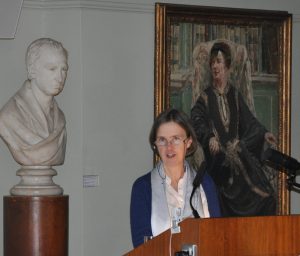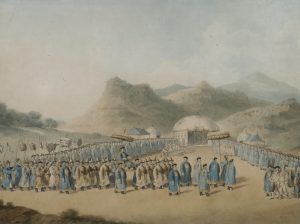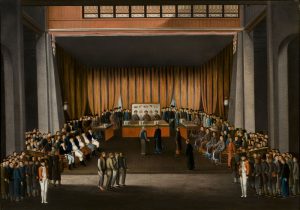Sir George Thomas Staunton
Last night, on 16 January, the Society was delighted to welcome Professor Henrietta Harrison (Pembroke College, Oxford) to lecture on “George Thomas Staunton and the Perils of being a China Expert in early nineteenth-century London”. Sir George Thomas Staunton (1781-1859) was one of the founders of the Royal Asiatic Society, and served as its Vice-President, but he is chiefly known as Great Britain’s foremost student of Chinese language and culture during the first half of the nineteenth century. Having accompanied his father on the Macartney Embassy to China while still a boy, Staunton had an early start in the study of Chinese, and by the time he returned to China as a young man to work for the East India Company, he was already more knowledgeable about Chinese than any other of his countrymen. Prof. Harrison provided an overview of Staunton’s career, explaining his translation works and interpreting efforts, as well as his role in East India Company operations and British diplomacy with the Qing dynasty; while also highlighting the several controversies in which he became involved. Prof. Harrison also revealed Staunton’s unique perspective on Anglo-Chinese relations, and his anxiety about the prospect of war between the two empires. The lecture was followed by a Q&A session with Prof. Harrison, and a reception.

Two of the artworks in our Collections illustrate some of those key moments in Staunton’s life. The first is a watercolour by William Alexander (1767-1816). Alexander was a Royal Academy student who was selected to accompany the Macartney embassy to China (1792-4). He made many drawings of the journey, some of which were engraved and used in Staunton’s account of the embassy. Other drawings were published in Alexander’s own publications. The artwork in the Society’s possession is entitled “The Approach of the Emperor of China to his Tent in Tartary to receive the British Ambassador”, dated by Alexander to 1799.

This painting was presented to the Society by Sir George Thomas Staunton in 1856. Alexander was not actually present at the event which took place on 14 September 1793 and when Staunton, though only a boy, was the only person able to converse in Chinese other than the interpreter. He was commissioned to recreate the scene and was helped by drawings made by Lt. William Parrish who had been present. The Emperor of China gave Staunton a silk purse on the occasion, which was also given by Staunton to the Society but, sadly, is no longer in our Collections.
The second artwork concerns the Chinese Court of Justice in the hall of the British factory at Canton, 9 April 1857. This oil-painting is by an unknown artist, painted c.1810, and envisages the Court set up to determine the murderer of a Chinese man from the sailors of the Neptune.

George Thomas Staunton acted as interpreter at the trial. There is another version of this painting at the National Maritime Museum, Greenwich. We also have a first hand report of the incident for which the trial was convened, within the Papers of Thomas Manning. This can be read on our Digital Library where this oil-painting can also be viewed.
Both these artworks are hanging in the Society’s premises, the first in the Council Room and the second in the Reading Room. Please do take the opportunity of seeing them if you come to the Society for any reason. One such opportunity will be next week’s lecture when Dr Edward Pulford from the University of Cambridge will lecture on “Time and History across China’s Northeastern Borders”. The event will take place at 6.30 pm on Tuesday 21 January. We hope many will be able to join us on this occasion.
